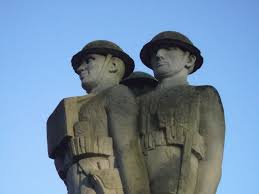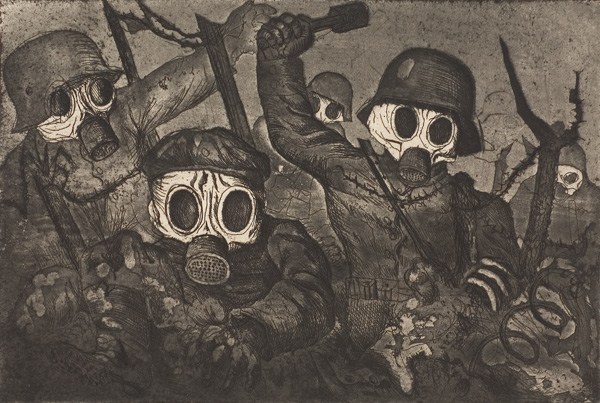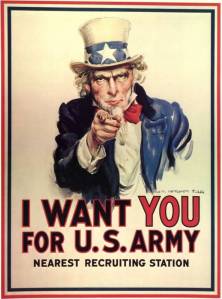24TH East Surrey Division


This is a gorgeous war memorial created by Eric Kennington (1888-1960). This piece comfortably sits in Battersea Park, London. This was the first publicly commissioned piece of art of Kennington and was created in 1924. This sculpture pays tribute to the men of the 24th Division British Infantry until serving on the front lines of the first World War. Kennington himself had experienced fighting in two different regiments. He became a war artist, and he actually purchased the Portland stone (a form of limestone) himself. It sits 6 feet 6 inches tall and in the shape of a cylinder. It continues the cylinder pattern by being surrounded by a cylinder hedge. It is a free-standing sculpture and eloquently depicts three soldiers standing together with a serpent at their feet. I love memorials. I am fr
Storm Troopers Advancing Under Gas

This powerful piece was etched on paper with ink by expressionist German war artist, Otto Dix in 1924. Its German title is “Sturmtruppe Geht Unter Gas Vor”. It was one of many in a series that Dix named “War”. This collection included graphic pictures of what Dix witnessed during his time on the ground in WW1. Dix was very dark and part of a radical expressionist group bringing light to the grotesqueness and the urban decay that was a byproduct of WW1. Propaganda was huge during this time, and Dix had the power of art to help get out his anti-Nazi message out to the world. This picture was shocking and scary. I couldn’t get the image out of my mind. I actually had no plan to use this piece because it was so evil looking. But it was impactful. There is so much movement in this still picture. I can feel them running right at me. The contrast and shading make the subjects stand out from the simple, dreary background. I definitely would not keep this work in my house, but it is an important piece of history and should be shown in museums.
I Want You!

This iconic U.S. propaganda poster was made with a lithograph by American artist, James Montgomery Flagg in 1916. It was part of a heavy Army recruitment campaign during War World One. Patriotic colors, with a stern, finger in your face Uncle Sam, really gets the point across that there was a need to fill during the war. Flagg modeled himself for this picture with a mirror. He used a similar poster from Britain from two years prior. Over four million copies were printed and seen all over America. I chose this piece because of the emotion it evokes in me. I feel most Americans can appreciate this iconic piece of patriotism. The placement of the authoritative “Uncle Sam” is centered in the middle of the page, drawing your eyes to his. Who could say no? The use of line and the stark contrast from the navy and red against the white really adds a simplicity to this piece. I would definitely own this piece and hang it with pride in my home, school, and I think with the emotion it evokes, should be seen more often than it is now.
Works Cited
“24TH EAST SURREY DIVISION.” War Memorials Online, www.warmemorialsonline.org.uk/memorial/111249.

I personally do not find the first two pieces to be aesthetically appealing. The soldiers in 24th East Surrey Division look rather stiff and unlife-like, while Storm Troopers Advancing Under Gas is extremely dark and frightening to look at. I like the last piece slightly more because of the details in Uncle Sam and the color combination that is used. All of these pieces, however, are very effective at showing the effects that WWI had on the art world.
One thing that I noticed about Storm Troopers Advancing Under Gas is that the figures seem to be reaching out towards the viewers. I agree with you that the contrast makes them stand out from the background, adding to this effect.
LikeLike
I love all your choices and the fact that you used propaganda art as two of your pieces! They definitely have something to do with WWI . My favorite would have to be the Storm Troopers Advancing Under Gas propaganda because it’s depicted as gruesome which the war was, it a honest portrayal of this war.
LikeLike
Your last statement was something I couldn’t agree more with, it seems we have lost some of that patriotic pride that used to be instilled in us. These days there really is an under appreciation for our military, so seeing an uncle sam every now and then I think would give us all a reminder not to take what we have for granite. My favorite of these artworks was the “Storm Troopers Advancing Under Gas” just because it gives of a cool kinda scary vibe that resembles with me. I don’t like the subject matter, but because it is a dark painting it makes me like the painting as a whole. The darkness of the colors to the evil depictions of Germans back then makes sense and goes together well. Darkness is usually related to the ‘evil’ and this work really does a good job of showing that. Great Post!
LikeLike